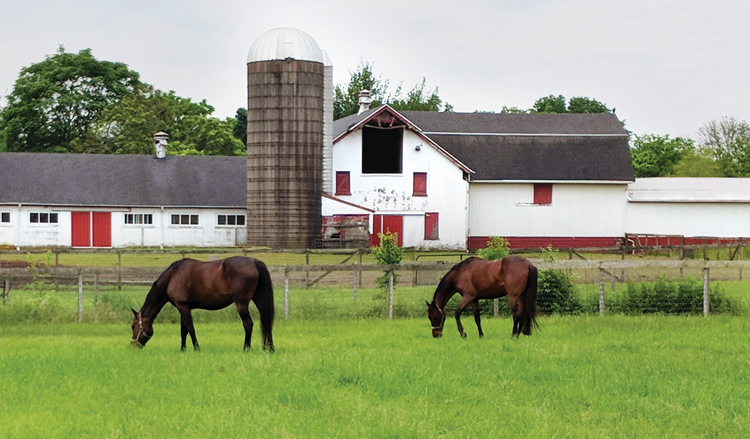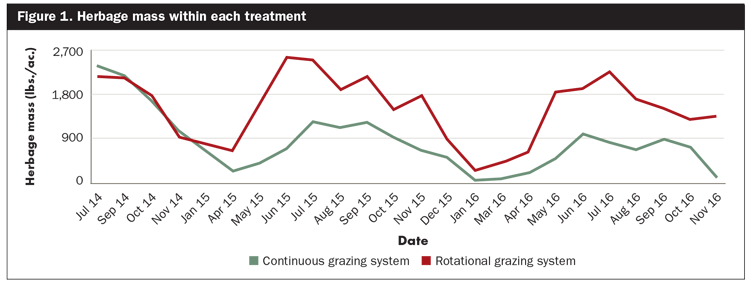The author is an equine extension specialist at Rutgers University.

Grazing is an economical way to feed horses a well-balanced diet, provide animals voluntary exercise, and reduce behavioral and health issues. While grazing systems have been studied extensively for livestock, grazing data extrapolated from these studies may be of limited value in crafting horse grazing recommendations.
The goals of horse producers as well as the digestive anatomy and function, forage preference, and grazing behaviors of horses differ from those observed in other species. Several studies have investigated potential benefits of rotational grazing on horse pasture productivity; however, most of these trials were conducted over a short period of time with no replication of pastures. Therefore, this article will highlight some of the work done at Rutgers University investigating the long-term benefits of rotational grazing for horses.
The first series of studies using Rutgers University’s Ryders Lane Environmental Best Management Practices Demonstration Horse Farm in New Brunswick, N.J., aimed to determine the effects of rotational grazing on pasture, soil condition, and horse condition, along with integration of novel forage options to maximize the summer grazing season.
The site included approximately 15 acres of pasture that was primarily composed of loam soils. A year prior to the studies, pasture fields were chemically treated to eliminate the existing vegetation, plowed to a depth of approximately 7 inches, disked, and pasture forage was reestablished.
Researchers adjusted soil fertility to optimum levels with lime and fertilizer, and pastures were seeded with novel-endophyte tall fescue at 7 pounds per acre, Kentucky bluegrass at 11.5 pounds per acre, and orchardgrass at 7.4 pounds per acre. The site was divided into two rotationally grazed areas and two continuously grazed areas.
Researchers divided 12 standardbred mares into four fields for a stocking density of roughly 1.3 acres per horse. Overall, the study found that the continuously grazed horses maintained higher body condition and percentage of body fat than the rotationally grazed horses.
The effects of the grazing system on pasture condition were substantial, with rotationally grazed pastures showing greater sward heights, herbage mass (Figure 1), and vegetative cover. Forage chemical composition also varied between the treatments, with rotationally grazed pastures having greater digestible energy, acid detergent fiber, and calcium and lower crude protein than continuously grazed pastures.

A companion study also demonstrated that while rotational grazing was effective in improving pasture forage productivity, it had minor influences on soluble carbohydrate content and ultimately had no apparent glycemic or insulinemic implications for the grazing horse. The results from these studies support the recommendation of rotational grazing for purposes of optimizing pasture yield and preventing deterioration of vegetative cover, which has important environmental and ecological implications.
In addition to horse condition and impacts on pasture forage, this study investigated the effects of stocking method on pasture soil. Continuous grazing damaged soil structure through compression of soil macropores, while rotational grazing promoted greater water infiltration rates at the range of pressure potentials predominantly controlled by macropores.
A greater macropore abundance is likely to contribute to the sustainability of the grazing system by increasing soil water content, decreasing soil temperature, and promoting the recovery of the pasture vegetation from trampling and abiotically induced stresses.
Seasonal Studies
Following the completion of the two-year rotational grazing study, researchers conducted a follow-up study to assess the ability of pastures to recover after winter rest. This study revealed that the choice of grazing system (continuous or rotational) has clear effects on pasture forage production in a subsequent growing season. In fact, winter rest alone may not be sufficient to overcome the negative consequences of overgrazing continuously grazed pastures.
Differences in sward height and herbage mass between continuously and rotationally grazed pastures persisted throughout much of the growing season following animal exclusion during the winter, and a total of nine months of rest was required for herbage mass in the continuously grazed pastures to reach similar production levels as the rotationally grazed pastures.
Effects on pasture botanical composition remained at the end of the study period, with a greater prevalence of grasses in pastures that had been rotationally grazed. Furthermore, vegetative cover in rotationally grazed pastures was consistently above the recommended levels for prevention of erosion and nutrient runoff, while low levels of vegetative cover in continuously grazed pastures presented a heightened erosion risk in the early spring.
Traditional pasture forages in temperate regions of the United States are mainly perennial cool-season grasses adapted for survival of cold winters and growth in periods of cooler temperatures during spring, early summer, and fall. However, these species are less tolerant of heat and drought, which leads to a period of low forage productivity often called the summer slump.
The summer slump presents challenges to horse producers, with implications for both the economic and environmental sustainability of equine operations. Supplemental feed is often needed to meet the nutritional needs of horses during the summer slump, resulting in higher feed costs.
In previous studies investigating the effects of stocking methods, horses managed in rotational pastures were restricted to a stress lot during times of low forage availability during the late summer to early fall when hot, dry temperatures led to less vigorous cool-season pasture grasses. Therefore, researchers conducted a subsequent study to determine if the warm-season annual Quick-N-Big crabgrass could be utilized to bridge the summer slump forage gap in cool-season grass equine rotational grazing systems.
The results of this study indicated that implementing an integrated rotational grazing approach by incorporating crabgrass may offer production advantages when compared to traditional cool-season grass rotational grazing systems. Carrying capacity and herbage mass were greater in crabgrass versus cool-season pasture sections during the critical summer slump period from mid-July to mid-September. However, in this study, integrated grazing resulted in less growth during late-season grazing. Further research is needed to identify strategies to improve season-long production in these systems.
The integrated rotational grazing approach did provide adequate nutrition to meet daily nutrient requirements and maintain body condition in grazing horses. However, the system did not result in marked differences in forage nutritional composition or horse condition in comparison to a traditional cool-season system.
Results from all of these studies taken together indicate that implementing rotational grazing may enhance pasture production and soil health over continuous grazing systems. The findings in the Rutgers grazing studies strengthen recommendations for implementation of rotational grazing systems in equine pasture management. The results will also inform equine grazing decisions by educators and farmers with the goal of improving the environmental sustainability of horse operations.
This article appeared in the January 2025 issue of Hay & Forage Grower on pages 28-29.
Not a subscriber? Click to get the print magazine.

